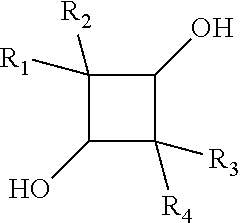Aliphatic polyester coating compositions containing tetramethyl cyclobutanediol
a technology of tetramethyl cyclobutanediol and polyester, which is applied in the direction of polyester coating, liquid surface applicator, coating, etc., can solve the problems of poor outdoor durability, poor solvent and chemical resistance, poor humidity resistance, etc., and achieve good tg retention of the blend, good solubility, compatibility and viscosity reduction
- Summary
- Abstract
- Description
- Claims
- Application Information
AI Technical Summary
Benefits of technology
Problems solved by technology
Method used
Image
Examples
examples
Preparation of Curable, Aliphatic Polyesters
[0362]The examples and comparative aliphatic polyester resins (Tables 1 and 2) were prepared according to the following procedure, calculation parameters included a number average molecular weight=1000, a hydroxyl equivalent weight=400, a hydroxyl functionality=2.5 and final acid number=10. For example PE3, calculation parameters included a number average molecular weight=1300, a hydroxyl equivalent weight=400, a hydroxyl functionality=3.25 and final acid number=10.
example pe1
[0363]The resin was prepared using a solvent process to help remove the water of esterification. The resin was prepared in a two-liter reaction kettle equipped with a heating mantle, mechanical stirrer, thermocouple, nitrogen blanket (1.0 scfh), oil-heated partial condenser (103° C.-105° C.), condensate trap, and water-cooled total condenser (15° C.). The condensate trap, kettle top and adapter from the kettle to the column were insulated by aluminum foil and fiberglass tape to facilitate water removal. A 0.25 wt. % excess of NPG and TMCD was added to the charge weight to compensate for glycol losses, and triphenylphosphite was added as a color stabilizer.
[0364]Stage 1—HHPA, TMP, TMCD and excess triphenylphosphite and xylene were charged to the reactor. Additional xylene (approximately 30 g) was used to fill the condensate trap. The temperature was then increased from room temperature to 75° C. over fifty (50) minutes to form a homogenous melt. Agitation (300 rpm) was started and th...
example pe2
[0371]The resin was prepared using a solvent process to help remove the water of esterification. The resin was prepared in a two-liter reaction kettle equipped with a heating mantle, mechanical stirrer, thermocouple, nitrogen blanket (1.0 scfh), oil-heated partial condenser (103° C.-105° C.), condensate trap, and water-cooled total condenser (15° C.). The condensate trap, kettle top and adapter from the kettle to the column were insulated by aluminum foil and fiberglass tape to facilitate water removal. A 0.25 wt. % excess of NPG and TMCD was added to the charge weight to compensate for glycol losses, and triphenylphosphite was added as a color stabilizer.
[0372]Stage 1—HHPA, AD, TMCD (and excess TMCD), triphenylphosphite and xylene were charged to the reactor. The temperature was then increased from room temperature to 75° C. over fifty (50) minutes to form a homogenous melt. Agitation (300 rpm) was started and the temperature increased to a maximum of 165° C. over sixty (60) minute...
PUM
| Property | Measurement | Unit |
|---|---|---|
| weight % | aaaaa | aaaaa |
| temperature | aaaaa | aaaaa |
| molecular weight | aaaaa | aaaaa |
Abstract
Description
Claims
Application Information
 Login to View More
Login to View More - R&D
- Intellectual Property
- Life Sciences
- Materials
- Tech Scout
- Unparalleled Data Quality
- Higher Quality Content
- 60% Fewer Hallucinations
Browse by: Latest US Patents, China's latest patents, Technical Efficacy Thesaurus, Application Domain, Technology Topic, Popular Technical Reports.
© 2025 PatSnap. All rights reserved.Legal|Privacy policy|Modern Slavery Act Transparency Statement|Sitemap|About US| Contact US: help@patsnap.com

